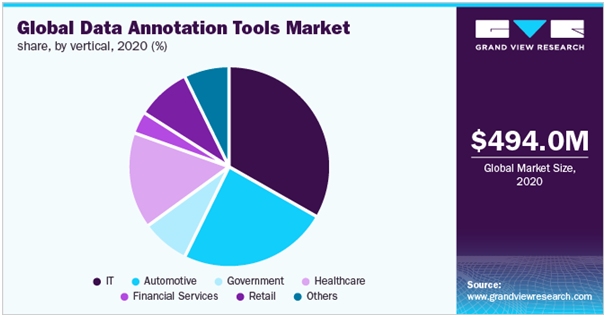Are you searching for the brains behind the best Artificial Intelligence models? Well, bow down to the Data Annotators. Even though data annotation takes center stage in preparing resources relevant to every AI-driven vertical, we shall explore the concept and learn more about the labeling protagonists from the perspective of Healthcare AI.
Yet, have you ever seen someone become a champion if they haven’t scaled beyond the challenges or helped others rise above the same? Well, this holds true even for the data annotators. Read on to know how.
Healthcare AI: Exploring the Vertical from a Practical PoV
According to Vantage Market Research, the market relevant to AI-driven Healthcare is expected to be valued at $95.65 Billion by the end of 2028. The report released in 2022 takes the $6.60 Billion mark in 2021 as the reference point and predicts a CAGR (Compound Annual Growth Rate) of over 46.1%.
From AI's role in Drug discovery to Genomics to Virtual Nursing to Robot-driven surgeries—intelligent models will start surfacing relentlessly over time. And to make these predictions stick, data annotation will have a major role to play,
But before we tread that space, let us know what kind of challenges are there in medical/healthcare AI still blocking global adoption?
Challenges in Medical AI
First of all, AI-specific challenges in healthcare aren’t just implementation. If you have envisioned a model and started developing the same—you are already there, in some capacity. The real challenges revolve more around the data labeling— as getting the right ones and preparing them for empowering the models can be an uphill task.
Yes, there exist compliance-specific challenges, but for now, we will restrict our discussion to the ones that can be solved upon deploying data annotation at scale.
So for starters, here are the relevant challenges to take care of:
● Erroneous labeling of sensitive data
● Inability to lend context to exponentially growing AI data
● Lack of sensitivity towards specific datasets, which can only be determined, if labeled
● Lack of impact despite using novel machine learning technologies like computer vision
● Onus on medical professionals to annotate specific image, voice, and video datasets
Data labeling can help you scale beyond the existing challenges with relative ease—provided you are already working on your next AI-driven healthcare product.
How does Data Annotation help medical professionals and resources alike?
Before we move any further, it is important to know that Data annotation or labeling is more like the last-mile solution for preparing perfect datasets for training healthcare AI models.
Provided your vendor has done its part when data procurement, cleansing, and de-identification are concerned, here are the advantages of following data annotation strategies:
Improved Quality of AI Resources
High-quality data annotators adhere to the ISO guidelines when it comes to labeling datasets. And with top-notch labeling comes accuracy—something a healthcare AI tool cannot do away with.
Scaling Requirements
A healthcare product driven by AI technologies cannot have a static tolerance toward scalability. Once you create the MVP (Minimum Viable Product), you might need to add in new healthcare datasets every now and then. And with each dataset comes the responsibility of labeling it to perfection.
Top-Notch Security
Medical professionals annotating data can be like inviting trouble as, unlike professional data annotators, they aren’t always aware of the GDPR guidelines, HIPAA standards, and more. Therefore, if your model has a unique use case tied to it, it is always advisable to go with experience.
Use-Cases
Here are some of the use-cases that strengthen our faith in credible data annotating services:
1. Imagine you want to develop an intelligent healthcare app capable of reading and responding accurately to user queries. Preparing a chatbot setup can be a tricky task if there is no data annotator to help you label historical and dynamically procured data accurately.
Well, you do not want the chat interface to return suggestions for common cold if the patient types in a gastrointestinal ailment.
2. Imaging tools need the purest form of data to be able to identify and diagnose ailments to perfection. Therefore, if you plan on developing one such application, the focus should be on getting truckloads of data in the first place, including images and videos, followed by annotating each resource with utmost accuracy.
Wrap-Up
Despite the choices, Data annotation or labeling comes forth as one of the more premium processes to train the most intelligent AI tools and self-learning machine learning models. And while there are multiple data annotators in the realm, it all comes down to semantic, video, audio, image, entity, and intent annotation when AI medicalis concerned.
As data annotators have their task cut out, especially for prepping the best resources for healthcare startups planning their first product—it is always advisable to rely on the experience, expertise, and credibility of the vendor before proceeding with the project.
Author Bio
VatsalGhiya is a serial entrepreneur with more than 20 years of experience in healthcare AI software and services. He is the CEO and co-founder of Shaip, which enables the on-demand scaling of our platform, processes, and people for companies with the most demanding machine learning and artificial intelligence initiatives.



No comments:
Post a Comment